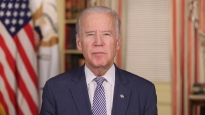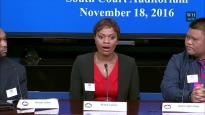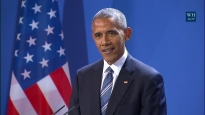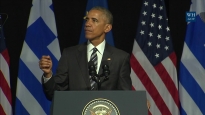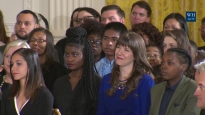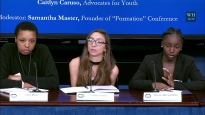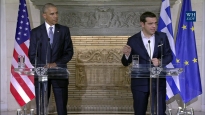President Obama Speaks at the Concussion Summit
May 29, 2014 | 1:04:35 | Public Domain
President Obama delivers remarks at the Healthy Kids and Safe Sports Concussion Summit at the White House.
Remarks by the President at the Healthy Kids and Safe Sports Concussion Summit
East Room
11:19 A.M. EDT
THE PRESIDENT: As a dad, when you -- Tori’s parents are here. And I have to imagine they are awfully proud of this remarkable young lady, and we really appreciate you taking the time to introduce me.
I want to welcome everybody here to the White House. I want to thank members of Congress, who are here. We’ve got leaders from America’s sports and medical communities, especially young people here like Tori, who did such a great job sharing her story today.
All across the country, there are millions of young athletes just like Tori who spend their weekends and summers on baseball diamonds and soccer pitches. And they put in extra practice so they can make the varsity or maybe even earn a college scholarship. Most of them are not as good as Tori was at her sport. I certainly wasn’t -- although, I had the same enthusiasm. And for so many of our kids, sports aren’t just something they do; they’re part of their identity. They may be budding scientists or entrepreneurs or writers, but they’re also strikers and linebackers and point guards. And that’s a good thing.
First of all, the First Lady thinks everybody needs to move. (Laughter.) And obviously there’s a huge public health interest in making sure that people are participating in sports. But sports is also just fundamental to who we are as Americans and our culture. We’re competitive. We’re driven. And sports teach us about teamwork and hard work and what it takes to succeed not just on the field but in life.
And I was a basketball player -- as I said, not as good as Tori was at soccer. But I learned so many lessons playing sports that I carry on to this day, even to the presidency. And still, when I need to relax and clear my head, I turn to sports -- whether it’s a pick-up basketball game -- and I’m much slower than I was just last week -- (laughter) -- or more sedate pastimes like golf, or watching SportsCenter.
And more than that, as a parent, Michelle and I have always encouraged our girls to play sports. One of the greatest transformations I think in our society has been how young women have been finally given the opportunity because of Title IX, and now you see just unbelievable women athletes who are getting the same exposure and experience and outlets for sports all across the country. And Malia and Sasha are part of that generation. They took for granted -- of course, we’re playing sports. And they played everything from soccer to basketball and tennis and track. So sports are important to our life as a family, just like they are for families all across the country.
The reason we’re here today, though, is all across the country parents are also having a more troubling conversation, and that’s about the risks of concussions. There’s a lot of concern, but there’s a lot of uncertainty. And as Tori’s story suggests, concussions are not just a football issue. They don’t just affect grown men who choose to accept some risk to play a game that they love and that they excel at. Every season, you’ve got boys and girls who are getting concussions in lacrosse and soccer and wrestling and ice hockey, as well as football. And, in fact, the Center for Disease Control reports that in the most recent data that’s available to us, young people made nearly 250,000 emergency room visits with brain injuries from sports and recreation -- 250,000. That number obviously doesn’t include kids who see their family doctor or, as is typical, don’t seek any medical help.
Before the awareness was out there, when I was young and played football briefly, there were a couple of times where I’m sure that that ringing sensation in my head and the need to sit down for a while might have been a mild concussion, and at the time you didn’t think anything of it. The awareness is improved today, but not by much. So the total number of young people who are impacted by this early on is probably bigger than we know.
Now, I say this not to scare people. We want our kids participating in sports. I’d be much more troubled if young people were shying away from sports. As parents, though, we want to keep them safe, and that means we have to have better information. We have to know what these issues are. And the fact is, we don’t have solid numbers, and that tells me that at every level we’re all still trying to fully grasp what’s going on with this issue.
Last fall, a comprehensive report found that there are too many gaps in the understanding of the effects and treatment for concussions. Researchers are still learning about the causes and consequences of these injuries. Communities are wondering how young it is to start tackle football, for example. Parents are wondering whether their kids are learning the right techniques, or wearing the best safety equipment, or whether they should sign up for -- to have their kids participate in any full-contact sports at all.
We’ve got some outstanding scientists here today like Francis Collins, the head of the NIH. There may be tests that at some point we can do to see if there is a particular susceptibility to concussions. Some people’s brains may be more vulnerable to trauma than others are. We don’t know that yet, but there may be some evidence that is worth exploring.
So with all of these questions swirling around, as a parent and as a fan, and in discussions with a lot of other parents and fans who happen to be in this White House, we decided why not use our convening power to help find some more answers. And today we’ve brought together the President of the NCAA, the MLS commissioner, senior leadership from the NHL, and US Soccer, and the NFL, and the NFL Players Association. We’ve also got some of the nation’s foremost brain experts. We’ve got doctors who work with kids every day from all over the country. We’ve got leaders in Pop Warner, and Little League, and Under Armour, and ESPN participating. And we’ve got members of Congress like Joyce Beatty, and Tim Bishop, and Bill Pascrell, all who have taken a great interest in this.
And because we’re all here and are looking for information, even if we may not agree on everything, the one thing we can agree on is, is that sports are vital to this country and it’s a responsibility for us to make sure that young, talented kids like Tori are able to participate as safely as possible and that we are doing our job, both as parents and school administrators, coaches, to look after them the way they need to be looked after. That’s job number one.
The good news is, across the country people eagerly signed up to participate here. They recognize this is an issue that is worth paying attention to. We’ve seen all 50 states pass laws requiring concussed athletes to get a medical clearance before they return to play. Folks from USA Hockey banned checking before 12 years old. In March, the NFL donated $45 million to USA Football for their Heads Up Football program, which emphasizes coach training and player safety.
On our part, this administration -- the CDC has spearheaded a public awareness campaign for parents, and athletes, and coaches, and school staff called “Heads Up.” And you can check it out at CDC.gov/concussion. That’s where we’ve compiled a lot of the best information available for parents. And while the number of concussions reported among young athletes has risen over the past decade, one reason is likely because players, coaches, and parents better understand symptoms of these injuries.
Still, there’s more work to do. We’ve got to have better research, better data, better safety equipment, better protocols. We’ve got to have every parent and coach and teacher recognize the signs of concussions. And we need more athletes to understand how important it is to do what we can to prevent injuries and to admit them when they do happen. We have to change a culture that says you suck it up. Identifying a concussion and being able to self-diagnose that this is something that I need to take care of doesn’t make you weak -- it means you’re strong.
At the same time, I want to point out that this is not just a matter for athletes. You’ll notice this big guy here, Ray Odierno, who is not only the leader of our Army, but also is somebody who plays football -- I don’t know if he still plays, although he could. (Laughter.) But as a leader of our Armed Forces, he sees the effects that injuries have had on brave men and women who serve in uniform, and all of us who careNF about them. That’s why Ray is here today.
And I’ve seen in my visits to wounded warriors, traumatic brain injury is one of the signature issues of the wars in Iraq and Afghanistan. The thing is, the vast majority of mild traumatic brain injury cases in the military occur outside deployment. So even though our wars are ending, addressing this issue will continue to be important to our Armed Forces. And as part of a new national action plan we announced last year, we’re directing more than $100 million in new research to find more effective ways to help prevent, diagnose and treat mental health conditions and traumatic brain injury -- because the more we can learn about the effects of brain injuries, the more we can do to help our courageous troops and veterans recover. And that obviously gives us more information about our kids, as well.
Today, by the way, I’m proud to announce a number of new commitments and partnerships from the folks in this room that are going to help us move the ball forward on this issue. The NCAA and the Department of Defense are teaming up to commit $30 million for concussion education and a study involving up to 37,000 college athletes, which will be the most comprehensive concussion study ever. And our service academies -- Army, Navy, Air Force, and Coast Guard -- are all signed up to support this study in any way that they can.
The NFL is committing $25 million of new funding over the next three years to test strategies like creating health and safety forums for parents, and they’re building on the program piloted by my own Chicago Bears to get more trainers at high school games. And the NIH is announcing the next step in this partnership with the NFL. They’re dedicating $16 million of the NFL’s previous donation toward studies and clinical trials to examine the chronic effects of repetitive concussions.
The National Institute of Standards and Technology will invest $5 million over the next five years to explore the development of lighter and smarter and more responsive materials for protective equipment. And I want to single out the New York Giants chairman, Steve Tisch, who is here and is donating $10 million of his own money to expand the BrainSPORT Program at UCLA to prevent, study, and treat concussions and traumatic brain injury in youth. So all these new commitments are terrific, and we want to thank everybody here for participating. (Applause.)
So just to wrap up, so you can hear from people who actually know what they’re talking about, these efforts are going to make a lot of difference for a lot of people -- from soldiers on the battlefield to students out on the football field. Take the Levine family from Rockville, Maryland, who are here today. Where did the go? There they are right there. Cheryl and Jason Levine have three boys, who when you look at them you know right away they’re brothers -- Isaac, Sidney, and Rueben. They have loved ice hockey since they were really young.
But when he was seven years old, Sidney suffered a pair of moderate concussions on the ice. A few years later, when Isaac was an eighth grader, he suffered a more severe concussion in a game. After the injury, both boys had headaches. They started struggling in class. They started acting out. Isaac’s concussion even kept him out of school for a while. And, as you might imagine, Cheryl was horrified; as she put it, “you only have one brain.” That’s a good point. And you want to make sure that you’re treating it right.
Fortunately, with the help of their doctors, both boys’ health and behavior improved. And Sidney was back on the ice 10 weeks after his concussion. He’s hoping to play varsity next year as a freshman. And last winter, Isaac played forward as his high school team won the state championship.
Now, Cheryl and Jason could have pulled their boys out -- it was such a scare -- and had their doctors recommended it, that’s what they would have done. But they knew that just like millions of kids across the country, kids love their sports. So Cheryl and Jason educated themselves on the issue, and with their doctor’s blessing and the support of the coaches and teachers, they’re encouraging their boys to lace up those skates and get out on the ice. And as Cheryl said, “My kids aren’t going to go on and play in the NHL.” I hope they know that, by the way. (Laughter.) “But what I’m worried about is getting through their teens while having fun and building confidence and doing the things they want to do, obviously within certain limits.” That’s some good parenting by Cheryl.
That’s what today is about -- is to give parents the information they need to help their kids compete safely. Let’s keep encouraging our kids to get out there and play sports that they love, and doing it the right way. That’s not a job just for parents, but it’s a job for all of us. And that’s why the public-private partnerships like these are important. In a few minutes, I know that many of you are going to take this discussion a step further with this panel of experts moderated by Pam Oliver, which we’re very grateful for.
But I want to thank all of you for coming here today, for your contributions to our kids’ future. And, most of all, I want to thank the young people who are here, particularly Tori, for highlighting why this issue is so important. We’re really excited. And, by the way, Tori although is not going to be playing soccer when she goes to college -- she’s graduating -- she does intend to stay involved in the sport, and I understand is going to be doing some coaching of some four- and five-year-olds this summer. And she is going to pass on some of the knowledge, hard-earned knowledge that she’s learned. And that’s why we know she’s going to be a terrific success in whatever she chooses to do.
Thank you, everybody. (Applause.)
END
11:33 A.M. EDT
|
November 19, 2016
|
November 18, 2016
|
November 17, 2016
|
November 16, 2016
|
|
November 15, 2016
|
November 15, 2016
|
November 15, 2016
|
November 15, 2016
|
- &lsaquo previous
- …
- 7
- 8
- 9
- 10
- 11
- 12
- 13
- 14
- 15
- …
- next &rsaquo
